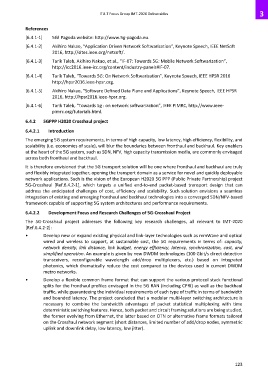Page 129 - ITU-T Focus Group IMT-2020 Deliverables
P. 129
ITU-T Focus Group IMT-2020 Deliverables 3
References
[6.4.1-1] 5G! Pagoda website: http://www.5g-pagoda.eu.
[6.4.1-2] Akihiro Nakao, “Application Driven Network Softwarization”, Keynote Speech, IEEE NetSoft
2016, http://sites.ieee.org/netsoft/.
[6.4.1-3] Tarik Taleb, Akihiro Nakao, et al., “IF-07: Towards 5G: Mobile Network Softwarization”,
http://icc2016.ieee-icc.org/content/industry-panels#IF-07.
[6.4.1-4] Tarik Taleb, “Towards 5G: On Network Softwarisation”, Keynote Speech, IEEE HPSR 2016
http://hpsr2016.ieee-hpsr.org.
[6.4.1-5] Akihiro Nakao, “Software Defined Data Plane and Applications”, Keynote Speech, IEEE HPSR
2016, http://hpsr2016.ieee-hpsr.org.
[6.4.1-6] Tarik Taleb, “Towards 5g : on network softwarization”, IEEE PIMRC, http://www.ieee-
pimrc.org/tutorials.html.
6.4.2 5GPPP H2020 Crosshaul project
6.4.2.1 Introduction
The emerging 5G system requirements, in terms of high capacity, low latency, high efficiency, flexibility, and
scalability (i.e. economies of scale), will blur the boundaries between fronthaul and backhaul. Key enablers
at the heart of the 5G system, such as SDN, NFV, high capacity transmission media, are commonly envisaged
across both fronthaul and backhaul.
It is therefore envisioned that the 5G transport solution will be one where fronthaul and backhaul are truly
and flexibly integrated together, opening the transport domain as a service for novel and quickly deployable
network applications. Such is the vision of the European H2020 5G PPP (Public Private Partnership) project
5G-Crosshaul [Ref.6.4.2-1], which targets a unified end-to-end packet-based transport design that can
address the anticipated challenges of cost, efficiency and scalability. Such solution envisions a seamless
integration of existing and emerging fronthaul and backhaul technologies into a converged SDN/NFV-based
framework capable of supporting 5G system architectures and performance requirements.
6.4.2.2 Development Focus and Research Challenges of 5G-Crosshaul Project
The 5G-Crosshaul project addresses the following key research challenges, all relevant to IMT-2020
[Ref.6.4.2-2]:
• Develop new or expand existing physical and link-layer technologies such as mmWave and optical
wired and wireless to support, at sustainable cost, the 5G requirements in terms of: capacity,
network density, link distance, link budget, energy efficiency, latency, synchronization, cost, and
simplified operation. An example is given by new DWDM technologies (100 Gbit/s direct detection
transceivers, reconfigurable wavelength add/drop multiplexers, etc.) based on integrated
photonics, which dramatically reduce the cost compared to the devices used in current DWDM
metro networks.
• Develop a flexible common frame format that can support the various protocol stack functional
splits for the fronthaul profiles envisaged in the 5G RAN (including CPRI) as well as the backhaul
traffic, while guaranteeing the individual requirements of each type of traffic in terms of bandwidth
and bounded latency. The project concluded that a modular multi-layer switching architecture is
necessary to combine the bandwidth advantages of packet statistical multiplexing with time
deterministic switching features. Hence, both packet and circuit framing solutions are being studied,
the former evolving from Ethernet, the latter based on OTN or alternative frame formats tailored
on the Crosshaul network segment (short distances, limited number of add/drop nodes, symmetric
uplink and downlink delay, low latency, low jitter).
123

